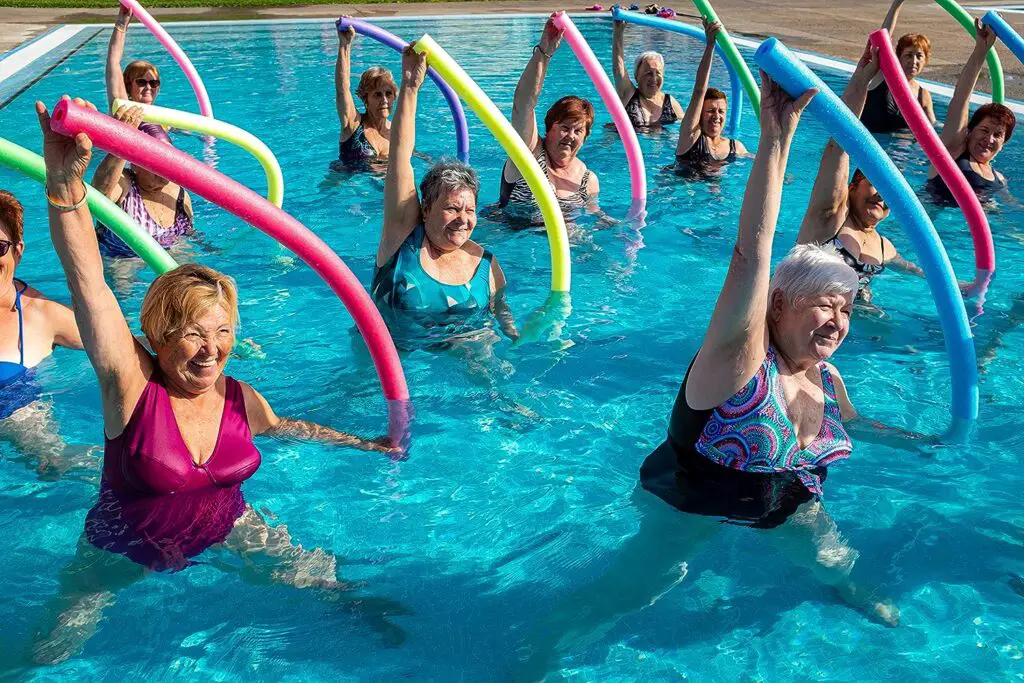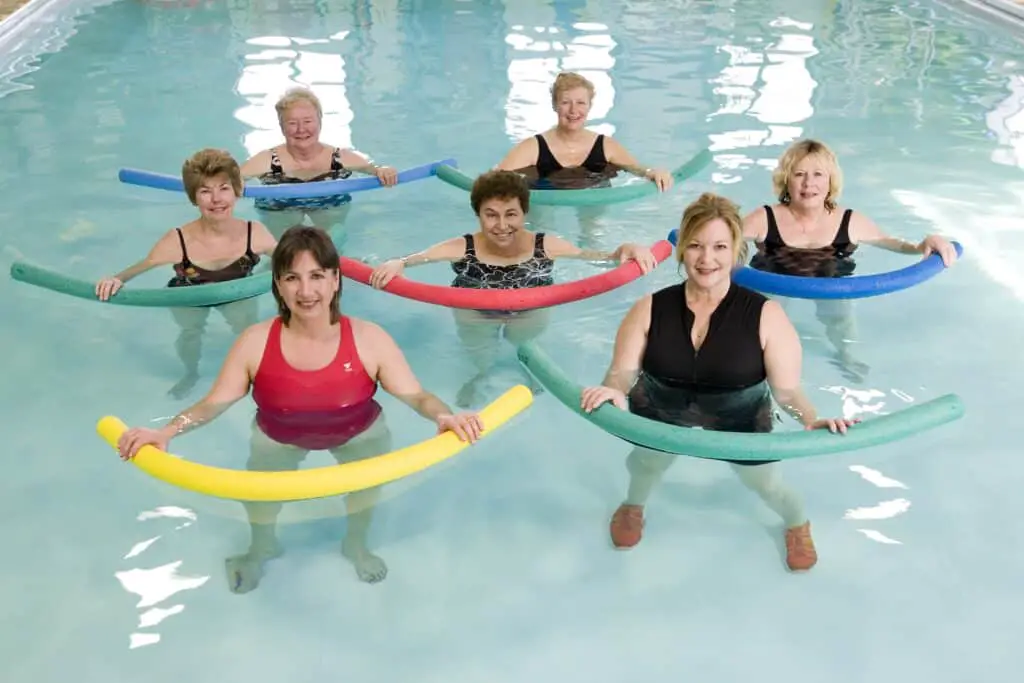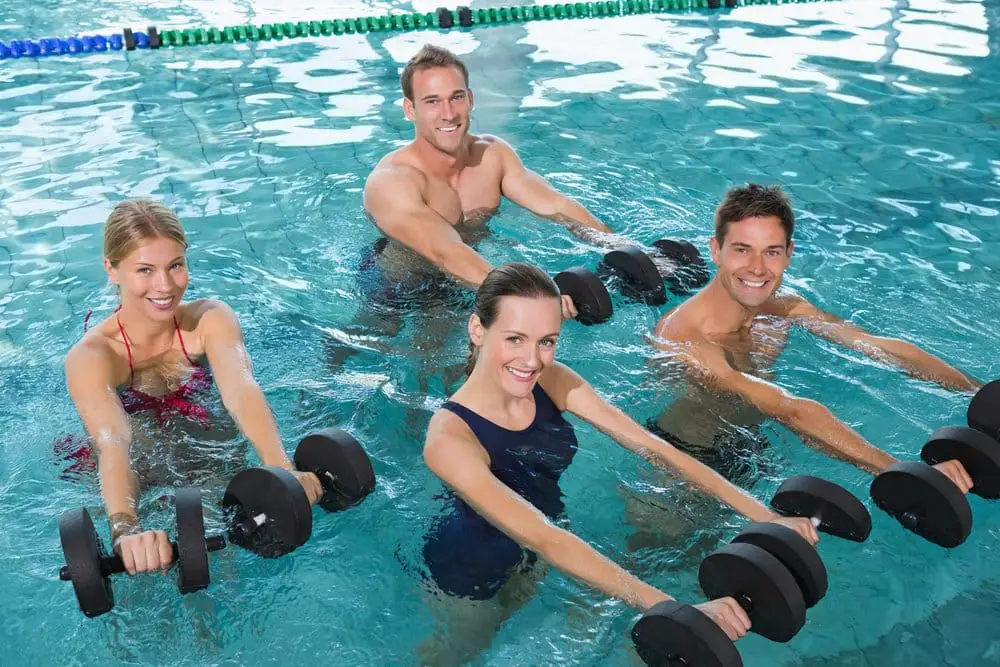Introduction
Is Water Aerobics Good For Weight Loss: In the quest for effective and enjoyable ways to shed those extra pounds and achieve a healthier, fitter lifestyle, water aerobics has emerged as a compelling option. The soothing embrace of water, combined with the invigorating benefits of aerobic exercise, makes water aerobics a popular choice for individuals looking to lose weight without the high-impact stress often associated with traditional land-based workouts. This aquatic fitness regimen has gained widespread recognition for its potential to not only burn calories but also improve overall physical well-being.
Water aerobics, also known as aqua aerobics or aqua fitness, is an exercise program conducted in a pool or aquatic environment, typically led by a trained instructor. It blends elements of cardiovascular exercise, strength training, and flexibility routines, all while taking advantage of the buoyancy and resistance properties of water. This unique combination provides numerous advantages, particularly for those seeking a weight loss solution that minimizes strain on the joints and muscles.
Potential benefits of water aerobics for weight loss, we will delve into the science behind this exercise form, uncover the key advantages it offers, and examine how it can be a valuable addition to your fitness regimen. We’ll also explore the various ways water aerobics can be customized to meet individual fitness goals, making it a versatile choice for people of all ages and fitness levels.
Whether you’re a seasoned fitness enthusiast or just embarking on your weight loss journey, understanding the role of water aerobics in achieving your goals can empower you to make informed choices about your fitness routine. Join us as we dive into the world of water aerobics to discover its potential as a fun and effective tool for weight loss and overall well-being.

How much weight can you lose with water aerobics?
A low-intensity average pool workout that lasts for 30 minutes can help you lose more than 300 calories. If you’re looking for an improved weight loss capacity, you can always increase the duration of water aerobics and bump up the intensity, modifying it to suit your needs.
The amount of weight you can lose through water aerobics varies from person to person and depends on several factors. Weight loss is primarily determined by the balance between calories consumed and calories burned. On average, a person can burn approximately 400 to 600 calories per hour during a moderate-intensity water aerobics session. However, weight loss is not solely determined by exercise; diet and lifestyle choices play a significant role.
To lose one pound of body weight, you generally need to create a calorie deficit of approximately 3,500 calories. So, if you maintain a consistent water aerobics routine and combine it with a balanced diet that promotes a calorie deficit, you can aim for a safe and sustainable weight loss rate of around 1 to 2 pounds per week. This rate is considered healthy and reduces the risk of muscle loss, which can occur with more rapid weight loss.
Moreover, water aerobics offers the advantage of being a low-impact exercise, making it accessible to individuals with joint issues or mobility limitations. This can be particularly beneficial for those who find high-impact exercises like running or weightlifting challenging.
Does water aerobics help lose belly fat?
The pool is the perfect place for a low-impact cardio workout that can also help you burn belly fat. Looking to burn belly fat without stressing your joints? If you have access to a pool, you can craft a low-impact routine with swimming strokes and traditionally land-based exercises like squats.
Water aerobics can contribute to overall fat loss, including reduction in belly fat. However, it’s important to note that spot reduction, or the idea that you can lose fat from a specific area of your body through targeted exercises, is a myth. Fat loss occurs systematically across the body as you create a calorie deficit through exercise and diet.
Water aerobics engages multiple muscle groups, including the core muscles, as you move through the water. This engagement helps tone and strengthen the abdominal muscles, which can lead to a more defined midsection over time. Water resistance provides a natural form of resistance training, promoting muscle growth and increasing your overall metabolism, which can aid in reducing body fat, including around the belly area.
To maximize the impact of water aerobics on belly fat reduction, it’s essential to maintain a balanced diet that supports your weight loss goals. Reducing your overall body fat percentage will ultimately contribute to a slimmer and more toned midsection.
How many times a week should you do water aerobics?
When you become a regular, five times a week is the sweet spot for water aerobics! As we’ve said, it’s completely low impact, so you needn’t worry about risking injury as long as you take it slowly and gradually.
The ideal frequency of water aerobics sessions depends on your fitness goals, current fitness level, and individual preferences. For general fitness maintenance and weight loss, engaging in water aerobics sessions at least 3 to 5 times per week. This consistent routine allows you to reap the benefits of calorie burning, improved cardiovascular health, and muscle toning.
However, it’s crucial to listen to your body and avoid overtraining. Adequate rest and recovery are essential for preventing fatigue and reducing the risk of injury. If you’re just starting, consider beginning with 2 to 3 sessions per week and gradually increasing the frequency as your fitness level improves.
It’s valuable to incorporate variety into your fitness routine. Mixing water aerobics with other forms of exercise can help prevent boredom and provide a well-rounded fitness regimen.
Is water aerobics better than walking?
“Recreational swimming will burn about the same calories as brisk walking,” says Dr. I-Min Lee, a professor of medicine at Harvard Medical School who studies the role of physical activity in disease prevention. One key advantage to swimming is that water makes you buoyant, which take the stress off your joints.
Whether water aerobics is better than walking depends on your fitness goals, preferences, and individual circumstances. Both activities offer unique benefits:
Water Aerobics: Water aerobics is a low-impact exercise conducted in the buoyant and resistance-rich environment of a pool. It is particularly suitable for individuals with joint issues or those seeking a full-body workout that engages multiple muscle groups. Water aerobics can burn a significant number of calories, improve cardiovascular fitness, enhance muscle tone, and promote flexibility. It’s also an excellent option for people looking for a social and enjoyable group exercise experience.
Walking: Walking is a simple and accessible form of exercise that can be done almost anywhere. It is an excellent choice for improving cardiovascular health, strengthening lower body muscles, and promoting weight loss when combined with a balanced diet. Walking is also low-impact and is generally easier to incorporate into daily life, making it a sustainable long-term fitness option.
The choice between water aerobics and walking depends on your preferences and specific fitness goals. If you have joint problems or enjoy the water’s resistance and buoyancy, water aerobics may be more appealing. On the other hand, if you prefer the flexibility of walking outdoors and are looking for a straightforward and effective way to increase physical activity, walking can be an excellent choice. Ultimately, the best exercise is one that you enjoy and can commit to consistently, as this is key to achieving your fitness and weight loss objectives
.
Is water aerobics better than running?
Swimming burns more calories than running the same distance. However, your weight will affect the number of calories you burn. Some studies show that in 30 minutes, someone weighing 155 pounds will burn 294 calories while performing low-impact step aerobics and 168 calories while performing water aerobics.
The comparison between water aerobics and running depends on your fitness goals, physical condition, and personal preferences. Both activities offer distinct advantages:
Impact and Joint Health: Water aerobics is a low-impact exercise, as the buoyancy of water reduces stress on your joints. This makes it an excellent choice for individuals with joint issues or those recovering from injuries. In contrast, running is a high-impact activity that can place significant stress on your joints, particularly the knees and hips. If joint health is a concern, water aerobics may be a safer option.
Cardiovascular Fitness: Running is a highly effective aerobic exercise that can improve cardiovascular health and promote calorie burn. It is known for its ability to enhance endurance and stamina. Water aerobics, while also effective for cardiovascular fitness, may provide a different experience due to the resistance of the water. It engages both the cardiovascular and muscular systems simultaneously, making it a full-body workout.
Muscle Engagement: Water aerobics engages a wide range of muscles as you move against the resistance of the water. This helps tone and strengthen your entire body. Running primarily targets the lower body muscles, particularly the legs and glutes. If you’re looking for a comprehensive workout that engages both upper and lower body muscles, water aerobics may be more appealing.
Injury Risk: Running carries a higher risk of overuse injuries, such as shin splints or stress fractures, due to its repetitive nature and impact on joints. Water aerobics, being low-impact, is less likely to lead to these types of injuries.
Variety and Enjoyment: The enjoyment factor is crucial for sustaining a fitness routine. Some individuals find the variety and social aspect of water aerobics classes more enjoyable than solo running sessions, which can lead to greater long-term adherence to a workout routine.
Ultimately, the choice between water aerobics and running depends on your specific fitness goals and physical condition. Some people may prefer a combination of both activities to enjoy the unique benefits each offers.
Is it OK to do water aerobics everyday?
Also, five sessions of water aerobics a week allow your body to rest and relax between your classes, which is important to completely minimize any risk of straining your body too much. Any more than five times is also OK, but there is no need for it.
The frequency of water aerobics sessions can vary from person to person based on their fitness level, goals, and overall health. While water aerobics is a low-impact exercise, doing it every day may not be suitable for everyone.
To allow for rest days in any exercise routine to prevent overuse injuries, promote muscle recovery, and avoid burnout. A balanced approach is key to long-term fitness success. Here are some considerations:
Intensity: The intensity of your water aerobics workouts matters. If your daily sessions are high-intensity and leave you fatigued, it’s essential to incorporate rest days or lower-intensity sessions to allow your body to recover.
Listen to Your Body: Pay attention to how your body responds to daily exercise. If you experience persistent fatigue, soreness, or discomfort, it’s a sign that you might be overdoing it. In such cases, it’s advisable to take a day or two off.
Variation: Incorporating variety into your workouts can help prevent boredom and reduce the risk of overuse injuries. You can alternate between water aerobics and other forms of exercise to give specific muscle groups a break.
Consult a Professional: If you’re considering daily water aerobics as part of a rehabilitation or therapeutic plan, it’s crucial to consult with a healthcare professional or fitness expert who can provide personalized guidance.
While some individuals may safely enjoy daily water aerobics, it’s essential to prioritize rest, recovery, and variety in your exercise routine. Always listen to your body, and if you have any underlying medical conditions or concerns, consult with a healthcare professional or fitness expert to determine the best frequency for your water aerobics sessions.
What are 3 benefits of water aerobics?
Water aerobics offers cardiovascular, muscular, and weight loss benefits, in addition to keeping your bones and joints healthy. Cardiovascular – Aerobic exercise helps to maintain and improve good cardiovascular health, and water aerobics falls into this category.
Water aerobics offers numerous benefits that make it an appealing exercise choice for people of all fitness levels and ages. Here are three key advantages:
Low-Impact Exercise: Water aerobics is gentle on the joints and muscles due to the buoyancy of water. This low-impact nature makes it an excellent option for individuals with conditions like arthritis, joint pain, or those recovering from injuries. It reduces the risk of stress-related injuries often associated with high-impact exercises.
Full-Body Workout: Water aerobics engages multiple muscle groups simultaneously. As you move through the water, you work both upper and lower body muscles, including the core. This comprehensive muscle engagement promotes strength, endurance, and improved muscle tone.
Cardiovascular Fitness: Water aerobics provides an effective cardiovascular workout. The resistance of the water increases your heart rate, improving cardiovascular health and endurance. Regular water aerobics sessions can help enhance your overall fitness level and contribute to weight management.
Social Interaction: Many people enjoy the social aspect of water aerobics classes. Exercising in a group setting can be motivating and help build a sense of community. It can also provide an opportunity to make new friends while pursuing your fitness goals.
Stress Reduction: The soothing environment of the water can have a calming effect and help reduce stress and anxiety. The rhythmic movements and warm water can promote relaxation and mental well-being.
Improved Flexibility: The resistance of the water encourages a wide range of motion, which can improve flexibility and joint mobility over time.
These benefits, along with the enjoyment factor, make water aerobics an attractive and sustainable exercise option for individuals looking to improve their overall fitness, manage weight, and maintain joint health.
Who benefits from water aerobics?
Water aerobics is an extremely versatile form of exercise with a lot of benefits. You can use water aerobics for weight loss, and prenatal water aerobics is one of the safest ways to exercise for pregnant women. This fun exercise is also one of the best low-impact ways for seniors to stay active and healthy.
Water aerobics is a versatile exercise option that can benefit a wide range of individuals, including:
Seniors: Water aerobics is gentle on the joints and provides a safe way for seniors to stay active and maintain their mobility. It can help improve balance and reduce the risk of falls.
Individuals with Joint Issues: People with conditions like arthritis, osteoarthritis, or chronic joint pain can engage in water aerobics without exacerbating their symptoms. The buoyancy of water reduces stress on the joints.
Rehabilitation: Water aerobics is often used in physical therapy and rehabilitation programs to aid in the recovery process after injuries or surgeries. It allows individuals to rebuild strength and range of motion with reduced impact.
Pregnant Women: Pregnant women can benefit from water aerobics as it provides a low-impact workout that eases the strain on the body while helping to maintain fitness during pregnancy.
Weight Loss Seekers: Water aerobics can contribute to weight loss efforts by burning calories and promoting muscle toning. It’s an enjoyable alternative to traditional high-impact workouts.
Athletes: Athletes can use water aerobics as a cross-training activity to improve cardiovascular endurance, maintain fitness during injury recovery, or add variety to their workout routines.
Those Seeking Stress Relief: The calming effect of water and the soothing environment of a pool make water aerobics an excellent choice for stress reduction and mental well-being.
Fitness Enthusiasts: Individuals looking for a fun and effective way to diversify their exercise routine can incorporate water aerobics to target various muscle groups and improve overall fitness.
Water aerobics is a versatile exercise option suitable for people of all ages and fitness levels. Its low-impact, full-body workout nature makes it accessible to many, and its benefits extend to improved joint health, cardiovascular fitness, muscle strength, and stress reduction. Whether you’re aiming to recover from an injury, maintain mobility in your senior years, or simply enjoy a refreshing and effective workout, water aerobics can be a valuable addition to your fitness routine.

Conclusion
In the pursuit of sustainable weight loss and improved overall health, water aerobics emerges as a highly compelling option. This aquatic fitness regimen, blending the therapeutic properties of water with the benefits of aerobic exercise, offers a myriad of advantages that make it a valuable addition to your fitness journey.
Water aerobics for weight loss, we have uncovered its unique ability to provide a low-impact yet highly effective workout. The buoyancy of water minimizes stress on joints and muscles, making it an ideal choice for individuals of all fitness levels, including those with mobility limitations. Moreover, water’s natural resistance fosters muscle engagement, enhancing calorie burn and promoting lean muscle development.
Beyond its physical benefits, water aerobics offers a refreshing and enjoyable workout experience. The soothing environment of a pool creates a sense of relaxation, reducing the perception of effort and making it easier to stay committed to your fitness routine. The group dynamics of water aerobics classes also foster a sense of community and support, further motivating individuals to achieve their weight loss goals.
It is evident that water aerobics holds great potential as a weight loss strategy. Whether you’re looking to shed a few pounds or embark on a transformative fitness journey, water aerobics can be tailored to meet your specific needs and objectives.
Incorporating water aerobics into your fitness regimen not only aids in weight loss but also enhances cardiovascular fitness, builds strength, and improves flexibility. Its low-impact nature makes it accessible to people of various ages and physical conditions, ensuring that anyone can reap the rewards of this aquatic exercise.
In essence, water aerobics is more than just a workout; it is an invitation to embrace the gentle power of water and embark on a holistic journey towards better health and a slimmer waistline. So, dive in, make a splash, and discover how water aerobics can be your secret weapon for achieving your weight loss goals while enjoying the process.

